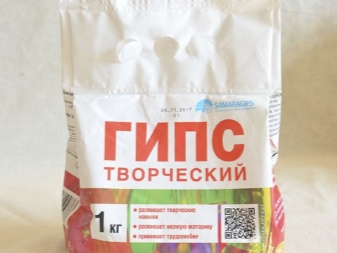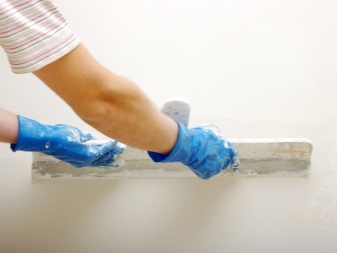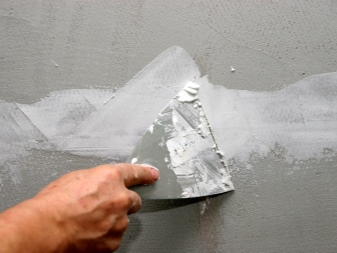What is alabaster and where is it used?

In the course of repair and finishing work, walls are often plastered and cracks are repaired. The optimal solution in this case would be the use of quick-drying building mixtures. Alabaster is recognized as one of the most popular materials - we will talk about its performance characteristics and applications in this review.

What it is?
Alabaster is a dry building mixture with a fine-grained structure. It is in demand when carrying out a wide range of finishing works. People have been familiar with this material since Antiquity. But if in the previous era it consisted mainly of calcite, today its base is calcium diaquasulfate, in other words, gypsum. The powder is produced by crushing gypsum stone and subsequent firing at a temperature of 150-200 degrees. The output is dry fine-grained mixture, before use it must be diluted in water.

The material is very popular. This is not surprising, given its undoubted advantages.
After hardening, the alabaster mixture becomes especially strong, therefore it can be used to form surfaces that are not subject to high weight loads.
If alabaster has been bred according to the technique, it will be very easy to work with. It is quickly leveled with the simplest spatula and does not require significant physical efforts by the master.

In the process of hardening, the working solution does not decrease in volume and does not shrink.
The lightweight alabaster putty can be easily combined with all types of load-bearing partitions.
Alabaster is distinguished by its increased sound insulation properties and water resistance.
The material is not covered with cracks even under the influence of subzero temperatures.
In addition, this building composition is environmentally friendly and fire resistant, therefore its use in residential and work premises is justified from the standpoint of fire safety.
Alabaster, unlike cement and other mixtures, quickly hardens and gains strength. This characteristic is considered both an advantage and a disadvantage of the mixture. Thanks to this property, an increased pace of facing work is maintained. However, it also leads to a decrease in the parameters of bending strength (2 MPa) and compression (4 MPa).

This creates limitations on the use of stucco. For example, it cannot be used as a brickwork, as well as for arranging a floor screed. Alabaster cannot withstand a deficit or excess of moisture. If you work in a kitchen or a room with a stove, where the air is too dry, or in baths with high humidity, alabaster immediately loses its physical and mechanical characteristics and begins to crumble.

Comparison with other materials
Novice finishers sometimes confuse alabaster and gypsum powder. They are sure that this is the same substance, since alabaster is made from gypsum stone, and they look the same. In practice, this is not at all the case - there are a number of factors that determine the difference between these substances.


Alabaster is only one of the types of gypsum powder, while it can be used exclusively in the repair and construction business. While gypsum has found widespread use both in creativity and in medicine. Gypsum forms the basis of alabaster powder, but due to the introduction of special additives, its strength increases.


If pure plaster can be easily picked out and scratched even with a fingernail, then sharp metal tools are required to deform the alabaster coating.
Another difference is that alabaster mass mixed with water is harder than plaster dough... That is why one material cannot work where another is in demand, and vice versa. At the same time, the gypsum mixture is much safer for people and pets - it does not produce harmful vapors that alabaster can synthesize if the mixing technology is not followed. In addition, it has been noticed that gypsum coatings are much less likely to develop fungus.

Specifications
Alabaster has the following technical characteristics:
-
setting time - from 6 to 30 minutes;
-
compressive strength - 4-7 MPa;
-
bending strength - 2.0 MPa;
-
shade - white or light gray;
-
water consumption - 0.6-0.7 liters per 1 kg of dry mixture.

The general operational parameters of alabaster gypsum include:
-
the building mixture easily fits on any bases - wooden, plastered, stone;
-
increased adhesion;
-
the ability to give the coating a perfectly aligned state in a time not exceeding 5 minutes;
-
no cracking and volume changes during drying;
-
a layer of solidified solution absorbs sounds, therefore it can be used as a means of soundproofing;
-
alabaster coating is warm to the touch and helps maintain a favorable indoor climate;
-
has a long shelf life.


Species overview
There are several types of stucco. Their distinctive features determine the scope of use of alabaster.
By the speed of solidification
The hardening period of the composition and the strength parameters of the finished coating directly depend on the size of the fraction of the building gypsum powder. The larger the grains, the higher the adhesion and the shorter the setting period. All alabaster on the market differ in the speed of hardening. They can be slow, medium and fast hardening.
- Slow hardening - set only 20 minutes after mixing the solution and finally acquire hardness after 40 minutes.

- Medium hardening - sets after 7 minutes after mixing, the optimum hardness is reached in 35 minutes.

- Fast hardening - set within 3-5 minutes after mixing and completely harden in a quarter of an hour.

By brand
In the overwhelming majority of cases, mixtures are in demand in repair and construction, marked G5 and G6. This alabaster is used as sheet plaster. It is in demand when creating gypsum boards, gypsum fiber sheets and gypsum board of various types. Among the areas of use of such asbestos, it is necessary to highlight the production of panels for the installation of interior partitions and the production of putty mixtures according to specific recipes.


To meet the needs of large industrial sectors, alabaster grades G13-G25 are more in demand. They allow you to create elements of increased strength. Such solutions fully comply with all basic construction safety standards.
Applications
Most often, alabaster is used for construction work and repairs. It is intended solely for indoor use, it is not used outdoors.:
-
used when creating sheets of drywall;
-
in demand for plastering wall surfaces and ceilings, as well as aligning them under wallpaper;
-
they can seal indentations for socket outlets, grooves, chips, holes, as well as cracks and cracks;
-
alabaster is relevant as a fixer for ceiling plinths, as well as stucco moldings and rosettes.





Alabaster plaster is in demand when creating art objects, making creative crafts and interior decoration.



Depending on the characteristics of natural raw materials, gypsum alabaster of pure white color and calcite, which has a pronounced grayish tint, are distinguished. Gypsum is smaller, more resistant to chemical attack, has increased aesthetic characteristics and wide functionality. The scope of use of alabaster largely determines the choice of material.


Alabaster mixture is sold in paper packages weighing from 5 to 50 kg. When carrying out work in significant volumes, it will be more practical to purchase a capacious container. The larger the package, the lower the cost of 1 kg.

To putty minor flaws and fix decorative elements, it is better to give preference to quick-hardening compounds. Their setting time is 2 minutes, and complete drying takes place in 15 minutes.

When working on a large surface, it is better to use a medium-hardening compound. You can work with them for 6 minutes - this time is enough to correct coating defects.
Slow-hardening mixtures are used for casting decorative elements. They freeze for at least half an hour, but at the exit they give increased strength.
How to breed?
Every master who works with building alabaster should adhere to the basic rules:
-
keep the proportions exactly;
-
choose the right container for mixing the mixture;
-
mix the mortar correctly;
-
produce the mixture as quickly as possible.

Before you start working with alabaster, you need to find the right vessel. It is not recommended to take buckets and bowls made of plastic, since the diluted solution will dry out quickly and you will have to constantly scrape off the frozen fragments from the walls of the container, this will require physical effort and lead to the appearance of dust. That is why most of the masters prefer rubberized containers, in which a small amount of powder is kneaded at a time. You can remove the remnants of the dried mixture from them by lightly squeezing the container. At the same time, you can make a vessel yourself, an old ball or a tire from a car will do for this.
If you need to dilute a lot of powder, you can take a plastic bucket, and lay out the bottom and walls with plastic wrap. During work, be sure to make sure that the container is not damaged. Otherwise, moisture will quickly drain out of it and you will spoil the finished mixture. To work with the finishing solution gives the desired effect, it is necessary to strictly adhere to the recommended proportions. Novice builders sometimes ignore this requirement, performing a batch "by eye".

Most often, such a composition hardens too quickly or does not freeze at all.
To prevent such troubles from happening, it is necessary to prepare a working solution as follows.
To begin with, pour 500 ml of water into the prepared vessel and slowly pour 1 kg of alabaster powder into the water, stirring constantly. The prepared mixture should have a uniform consistency. The inclusion of lumps of adhered gypsum is not allowed.

In this case, it is very important not to overdo it with mixing the composition. If you stir the alabaster for too long, then the ready-made mortar may lose its strength characteristics. Usually the mixture begins to thicken 5 minutes after mixing, taking into account the type of alabaster, complete hardening occurs after 15-40 minutes. Accordingly, for each batch, you should prepare as much of the mixture as you can spend in 5-6 minutes.
The mortar made according to this instruction is suitable for fixing communications, sealing cracks and performing simple finishing manipulations. If alabaster is needed for plastering walls, then the recipe is slightly different. Before proceeding directly to the site, you should mix the dry composition, which will subsequently be filled with water with the introduction of alabaster.

As a container, you can take an arbitrary container with a hard bottom or an old tire, the height of the walls should be 10 cm or more. First, river or construction sand must be poured into the vessel, then lime is poured there at the rate of 5 parts per 1 part of sand. The dry components are thoroughly mixed until a homogeneous consistency, after which you can pour in the liquid, stirring constantly.
The finished substance should resemble sour cream.
Next, you need to knead the alabaster dough according to the first recipe. After that, the prepared mixture must be transferred into a vessel with lime at the rate of 1 to 4, and stirred promptly. The substance must be used immediately after preparation.

How to apply correctly?
At the initial stage of work, it is necessary to spread the coating, for this you will need a special shovel with a curved handle. A small volume of the mixture is scooped up with a trowel and quickly thrown onto the wall surface. The most important thing is not to overdo it, otherwise you will simply transfer the entire trained workforce.
Then you need to smooth the mixture with a spatula and apply another layer of alabaster, it should be thin. In this case, it must be applied before the previous layer is completely dry. If you missed this moment, then the surface should be thoroughly sprayed with water.

When the finishing layer of alabaster is completely dry, you need to go over it with a construction float - it is best to take a plastic one. Processing is carried out with rotational movements counterclockwise.

In the process of work, you need to press the grater as tightly as possible to the base to be treated.
In fact, the preparation of kneading, directly kneading and applying the plaster of paris solution at home is not a big deal. The only thing to keep in mind is the small amount of time you will have at your disposal. You are unlikely to be able to slow down this process, so application and leveling should be done as quickly as possible.









The comment was sent successfully.